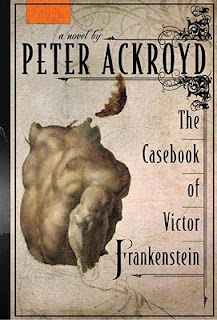The Casebook of Victor Frankenstein
 There has been a lot of metafiction concerning the great characters of nineteenth-century literature, most notably Sherlock Holmes and Dracula. So why not Victor Frankenstein and his creature? Peter Ackroyd, noted literary biographer, has written a novel in which the scientist searching for the spark of life actually meets his creator--Mary Shelley.
There has been a lot of metafiction concerning the great characters of nineteenth-century literature, most notably Sherlock Holmes and Dracula. So why not Victor Frankenstein and his creature? Peter Ackroyd, noted literary biographer, has written a novel in which the scientist searching for the spark of life actually meets his creator--Mary Shelley.The result is neither fish nor fowl. It is a moderately exciting thriller, but at the end trails off. It is also a moderately interesting exercise in academia, offering portraits of Mary and Percy Bysshe Shelley, Lord Byron and John Polidori. But as I was reading the book, and noting the parallels between it and Shelley's novel from 1818, I was forced to wonder why it was written, when I could have just reread the original?
A first-person narrative, Frankenstein is a Genevan who goes to school at Oxford, where he meets and befriends Percy Shelley. Inspired at a lecture on galvanism by Humphry Davy, and flush with funds after the death of his father, he drops out of school and sets up a laboratory in London, where he experiments with electricity on dead tissue, seeking to reanimate it. He hires some "resurrection men," graverobbers, who supply him with fresh corpses. When he lucks into one that is only hours dead, his experiment succeeds, with horrible consequences.
Much of the action parrots the original, with bizarro-world differences. As said, this takes place in England, not Germany, and the creature is not stitched together with an abnormal brain. But he is super-human, and intelligent, learning by hiding in a family's barn. In retribution, he kills someone close to Frankenstein (Shelley's first-wife Harriet, who in reality got dumped by Shelley) and then demands that he create a mate for him.
The story then deviates from the original, indeed traveling to the point where the story was originally created, the summer that the Shelleys, Byron and Polidori spent on Lake Geneva, where their ghost-story contest produced Shelley's novel. That summer has inspired many recreations (at least two films have been made about it) and I didn't find Ackroyd's telling of to add any spectacular new wrinkles.
After a terrific middle--the scene in which the creature comes to life are page-turning, the book winds down to a less than satisfactory ending, with a hastily tacked on close that is like an M. Night Shamalyan film. For those who are interested in all things Frankenstein, or in the romantic writers, this book will prove interesting, but if you're new to it all just get the original novel.


Comments
Post a Comment